How metal pipes are bent: technological details of the work
Pipes bent at an angle have found application in the oil and chemical industries, mechanical and apparatus engineering.Not a single architectural or construction project can do without them.
All kinds of fittings can be used for turns, but then leaks may occur, and sometimes this is simply unacceptable for aesthetic reasons. A more attractive appearance and high reliability are ensured by bending pipes - a process that does not violate their integrity.
We will tell you how best to bend a metal pipe using both cold and hot technology. The article we presented describes the specifics of bending pipes made of various materials. The features of working with profile and conventional round pipes are given.
The content of the article:
Features of the bending process
Each metal has its own characteristics; without taking them into account, it is impossible to give rolled metal a complex shape. The bent pipe is subject to radial and tangential forces.
The former deform the section, and the latter contribute to the appearance of folds. The main requirement for the final result is that the cross-section of the pipe should remain unchanged, and there should be no corrugations on the walls. Bending allows you to minimize the number of welds when laying pipelines with all kinds of bends.
Pipe bending methods
Based on the required bend angle, material and diameter of the pipe, bending can be done manually or using special equipment. There are also hot and cold bending, with and without filling the pipe cavity.
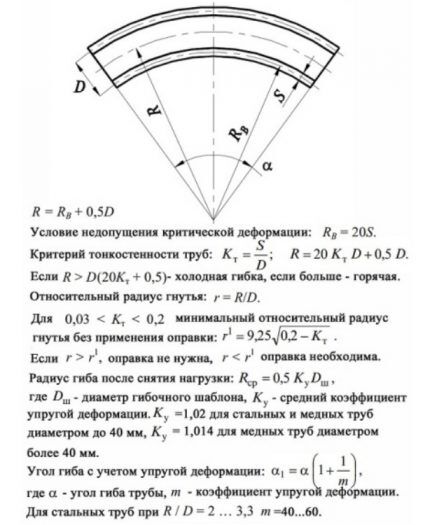
After the load is removed, a phenomenon called springing occurs, which is directly proportional to the elastic modulus of the material. The amount of possible deformation also depends on the bending method used and the geometry of the object.
Specifics of hot technology
This method is chosen when it is necessary to bend a pipe with a diameter of 10 cm or more. Pipes are deformed hot, both manually and using mechanisms. There is such a thing as a minimum bend radius.
The length of the pipe zone that needs to be heated is determined based on the pipe diameter and bending angle. In this case, the rounding cannot be less than the pipe diameter multiplied by 3.
Find the length of the heated section using the formula:
L = α x d / 15
In the formula: L is the required length in mm, α is the bending angle in degrees, d is the outside diameter of the pipe in mm, 15 is the coefficient. Let's say a pipe with a diameter of 200 mm needs to be bent at an angle of 60⁰, then L = 60 x 200/15 = 800 mm, i.e. 4 diameters.
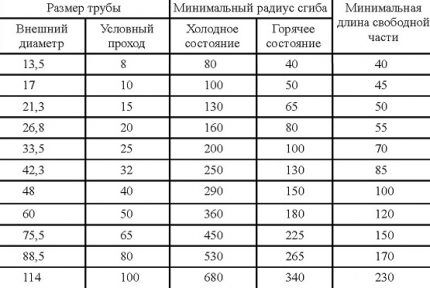
To bend the pipe, it must be heated to 900⁰. The optimal temperature for starting bending is 760⁰, and at the end - 720⁰C. When burned, the strength characteristics of the material deteriorate.
The hot bending process includes several operations:
- making a template;
- sand packing;
- site marking;
- heat;
- bending.
To prevent the cross-section of the pipe from being deformed and sweet spots not forming on its inner part at the bend, the internal space is filled with quartz sand.
The sand is first dried and calcined in order to remove organic impurities at a temperature of 150 to 500⁰, and then passed through a fine sieve with a cell size of 3.3 x 3.3 mm. Before you start stuffing the pipe, you need to plug one end of it.
Wooden or metal plugs with a hole for gases to escape are used as plugs. Fine and wet sand cannot be used, because... the first one is sintered under thermal influence and firmly adheres to the walls of the pipes.
The second, as a result of the formation of steam, contributes to the development of high internal pressure, which can cause the plug to fly out. The presence of stones in the packing is unacceptable; they can push through the pipe wall.
The process of stuffing the pipe is very labor-intensive, so it is transported to the tower and given a slightly inclined or vertical position. Since the quality of the bend is directly dependent on the compaction of the packing, the pipe is continuously tapped throughout the process. A dull sound indicates that the workpiece is well filled.
Before proceeding directly to the main operation, areas of future bends are drawn on a pipe filled with sand, attaching a template. The pipes are heated in furnaces or furnaces. Bend both manually and mechanized.
In the latter case, special plates are used, equipped with thrust posts, with the help of which the heated section of the pipe is fixed, and clamps that serve to hold the end of the pipe on the plate.A cable is put on the opposite end of the pipe, the tension of which with the help of a winch or capstan causes the pipe to bend.
To prevent the pipe walls from deforming, gaskets - straight or curved - are placed in the space of the pipe stand. The free end with the cable attached to it is secured using a stand. During the process, the geometry of the pipe is monitored by periodically applying a template to it.
Having bent the pipe at the desired angle, the plugs are removed from it by burning or simply knocking them out. The sand is poured out, the pipe is cleaned and washed. Perform a final bend check using a template.
Cold bending
To change the configuration of pipes of small diameters, various manual devices are used; for large diameters, mechanized pipe benders are used. At home, bending of water and gas pipes is most often required. steel pipesused in the construction of water supply and heating systems.
Bending a pipe at 90⁰ is called a bend, 180⁰ is a roll, with the formation of a ledge is a weft, and in the form of a loop is a bracket.
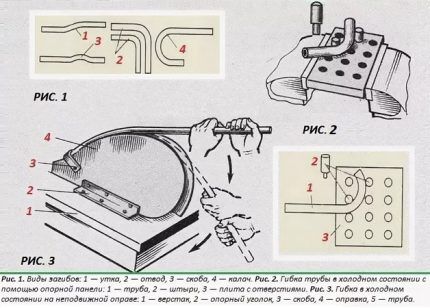
There are other devices for manual bending. At home, to make a coil for heating water, a stainless steel tube with a diameter of about 20 mm is simply wound onto a piece of large diameter pipe. First, a bracket is welded onto a large pipe, placed on supports and clamped.
The tube is tightly filled with sand and closed with plugs, then inserted into the bracket and winding begins. The pipe used as a template needs to be twisted, so it will require the efforts of at least two people. Having finished winding, the coil is leveled.
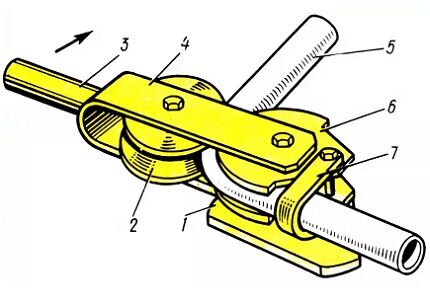
Bending a pipe made of stainless steel or other material at home can be done using the simplest device. It is advisable to use it for small volumes of work.
You can build a simple mechanical pipe bending machine with your own hands, especially if you have welding skills and are familiar with a welding machine:
For the manufacture of primitive pipe bending device You need a concrete slab, metal pins and a hammer drill. The slab is divided into cells 40 x 40 or 50 x 50 mm. Using a puncher, holes are drilled in the corners of the cells and pins are inserted into them.
The tubular product is inserted between the pins and, applying force, is bent. The accuracy with this bending method is not ideal, but it is quite sufficient for using the workpiece at home. For bending with higher precision, you can use a device made on the basis of a jack.
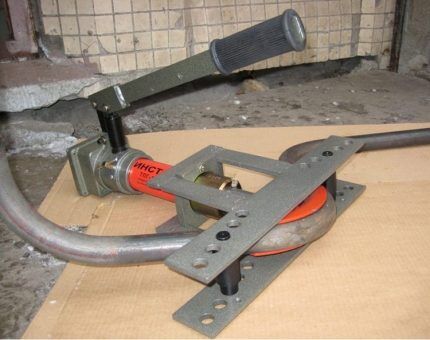
To prevent the internal lumen of the pipe from deforming, means are used to counteract this process from the inside. Sand is most often used as internal limiters. In this case, a plug is inserted into one end of the pipe, sand is poured through the other, and then it is plugged with a plug. Next, bending is performed.
Sometimes the limiter is a spring specially made for this purpose. For winding, wire with a diameter of 1 to 4 mm is used. The spring should fit freely into the pipe at the bend point; a portion of the wire is left outside.
The hydraulic system of hand tools, portable and stationary machines significantly facilitates the bending process and accelerates the process of pipe deformation:
After the bend is completed, the spring is removed by pulling the wire. When working with a pipe with a square cross-section, wire with the same cross-section is selected to make a spring.
A bundle of wire consisting of separate segments, which are pushed inward one at a time to the point of future bending, is also suitable for this purpose. After the operation is completed, the segments are also removed one by one. You can manually bend a stainless pipe with a cross-section of up to 4 cm and a wall thickness of 0.3 cm.
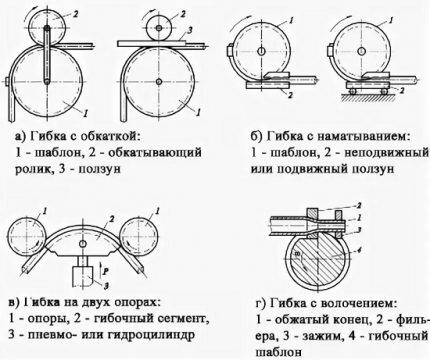
To work with large diameters, professional equipment is required. There are pipe bending machines equipped with a mandrel. This structural element is an ordinary metal rod.
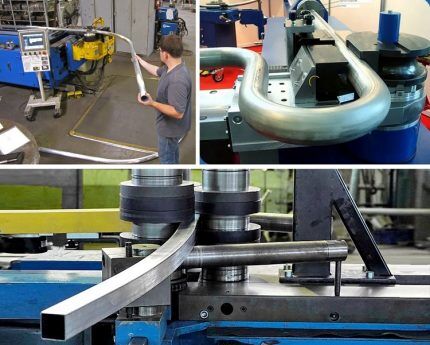
Before starting the bending process, it is placed inside to prevent deformation of the pipe walls. The mandrels included in the kit have different sections, so you can choose the one you need for a specific diameter of pipe products.
Changing the configuration of pipes made of non-ferrous metals
Non-ferrous metals have a very useful property - high ductility. However, they are not strong enough. During the bending process, as a result of the application of compression and tension forces, the pipe may collapse or rupture. To prevent this from happening, you must strictly follow the technology.
How to bend copper and brass pipes?
Both hot and cold methods are used for bending copper and brass pipes. When choosing the first, sand is chosen as the internal filler, and molten rosin is used as the second filler. The bending technology is the same as for steel pipes.
Tubular products made of copper and brass are subject to annealing and subsequent cooling before cold bending. The temperature range for both materials is the same - from 600 to 700⁰С. The difference is in the cooling medium - copper is placed in water, and brass is cooled in air.
Once the process is complete, the rosin is removed by smelting it. To prevent pipe rupture, the process should never be started from the middle of the pipe, only from the ends. Both simple tools and complex machine equipment are used as bending devices.
Manual pipe benders work due to human physical efforts, while hydraulic ones reduce these efforts to a minimum. Both are equipped with interchangeable nozzles to allow you to select the desired diameter.
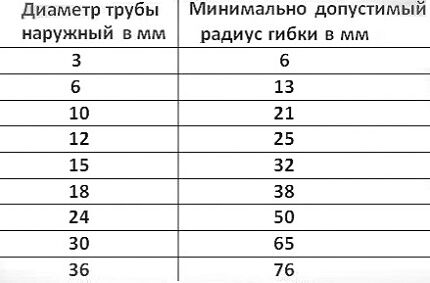
It is much easier to work with copper and brass pipes than with steel ones, but metal deformation during bending occurs according to the same laws of physics. In the bending section, the outer surface experiences tension, as a result of which the walls become thinner.
Inside the pipe, reverse processes occur - the wall shrinks and becomes thicker. There is a risk of the round section turning into an oval and reducing the nominal diameter, so bending should not be started without taking measures to prevent these phenomena.
Aluminum pipe bending
Basic methods aluminum pipe bending the same as brass or copper:
- pushing between rollers;
- rolling;
- rollback;
- pressure.
Before making a decision about how and in what way to bend aluminum pipes, you need to familiarize yourself with each one. The first method is used for thin-walled pipes with a maximum diameter of 10 cm, when it is necessary to obtain a gentle bend with low accuracy requirements. The minimum radius is strictly regulated here. Its size is 5-6 pipe diameters.
The curvature of the section is determined by the position of the deflection roller. Interior decorative elements are most often made in this way. The second method is to bend large-diameter pipe material, for which 3-roller pipe benders are used.The pipe is pulled between drive rollers, the orientation of which determines the bending radius.
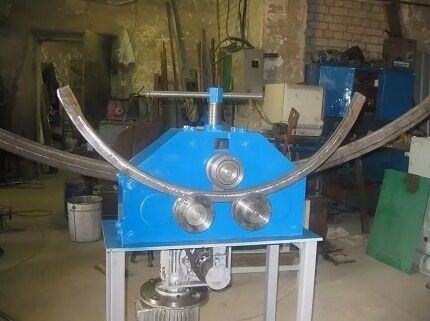
The accuracy of this method is even lower than the previous one, but the part can be re-bent and the process repeated until the desired geometry is achieved.
Bending of thin-walled aluminum pipes can be done manually with proper preparation:
The rolling method does not provide for the presence of internal filler, so it is not used to obtain small radii.When choosing this method, it will not be possible to fulfill the strict requirements regarding the ovality of the section at the bend.
To deform an aluminum pipe by pressure, presses are used with stamps installed on them with a matrix of the desired shape. The given geometry is obtained as a result of the influence of pressure exerted from the outside.
In some cases, the pressure can be internal, when the pipe is placed in a mold and liquid is supplied inside with a pressure sufficient to press it against the walls.
It is not easy to bend duralumin pipes, because... This material is quite hard and springy. To facilitate the process, they are fired immediately before bending at a temperature of 350 to 400⁰C, then wait until the pipes cool naturally in the air.
Methods for bending large diameter pipes
Relatively recently appeared methods are bending pipes using industrial and high frequency currents and bending with tension. In the first case, a high-performance high-frequency installation is used, in which a pipe with a diameter of 95 - 300 mm is heated, bent and cooled.
It consists of two parts - a mechanical one in the form of a bending machine and an electrical one, which includes an electrical part and a high-frequency installation.
The pipe is deformed only in the heated area located in the inductor zone. The geometry changes to a given size under the influence of a deflecting roller. Using this method, you can obtain a bend with a small radius curvature.
Bending using the second method is carried out on bending and stretching machines, which include a rotary table. The pipe is subject to large tensile and bending forces. This is how steeply curved bends are obtained with a constant wall thickness along the entire circumference.
The method is used for bending large-diameter pipes used in the aviation, automotive, and shipbuilding industries, where high demands are placed on the pipeline. The advantage is the ability to bend pipes with a wall of 2 - 4 mm by 180⁰.
Features of profile bending
Profile pipe products have a more aesthetic appearance than their round counterparts, which is why they are often found in household structures. When bending, a compressive force acts on it from the inside, and a tensile force from the outside. You should carefully select the bending method before starting this operation.
The profile range includes pipes with a cross-section in the form of a square, oval, or rectangle.
There are several nuances and you should not forget about them when doing flexible profile pipes at home without special equipment:
- The optimal length of the bending section for corrugated pipes with thin walls and a cross-section of up to 2 cm is the height of the pipe multiplied by 2.5.
- For thick-walled pipes, the length of the bending zone is determined by multiplying the cross-section by three. Otherwise, cracking of the material from the outside or deformation from the inside cannot be avoided.
- The minimum value of the radius of curvature is the bending section multiplied by 2.5.
Without taking these requirements into account, you can’t even hope for a good result. The bending methods do not differ from those used when working with products with a round cross-section. In addition, you can use the manual bending method with cross cuts, which are made on three sides of the pipe.
The length of the cuts and their number are determined by calculations. Let's say there is a pipe 40 x 90 mm. You need to perform a full turn, i.e. bend along the wall 40 mm at an angle of 180⁰ with a radius of 150 mm. First, calculate the length of the semicircle based on the outer radius:
L = (2π r: 2 = 2x 3.14 x 190) : 2 = 596.6 mm
For the inner radius, the calculations are the same:
Lin. = (2 x 3.14 x 150) : 2 = 471 mm.
The sum of the cut lengths on the inner radius is determined by the formula: Lout = L – Lin = 596.6 – 471 = 126 mm.
Those who want to do it themselves manual pipe bender or profile pipe bending machine With your own hands, in the articles we offer you will find a lot of useful information, diagrams and useful recommendations.
If we take into account that a grinder can make a cut 5 mm wide, then on a bend plane 126 mm long you will get 25 slits, after which the pipe is bent until the edges of the cutouts touch. The slots are welded and the seams are cleaned.
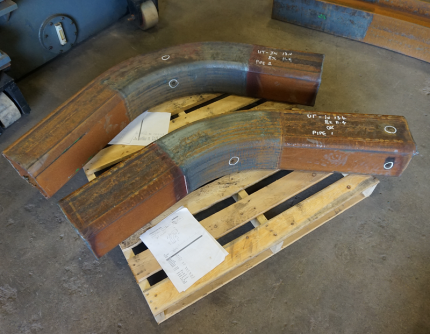
There is another way in which profile and round pipes are bent, but it can only be used in winter. To do this, insert plugs into the ends of the tube, pour water inside and wait until it hardens. The pipe is bent, controlling the process with a template, then the plugs are removed and the liquid is removed.
Useful: How to make a gazebo from a profile pipe with your own hands.
Conclusions and useful video on the topic
Video #1. How to bend a pipe using improvised means, you will learn from this video:
Video #2. How to bend a pipe of any cross-section into a circle:
Video #3. A homemade pipe bender is a necessary thing in the household:
When performing repairs or building a house, the need to bend a pipe - round or profile - often arises. If the volume is small, you can do it yourself. Mass bending of pipe products is possible only with special equipment.
Tell us about how you bent a metal pipe to build a greenhouse or other purposes. Share with site visitors technological nuances known only to you. Please write comments in the block below, post photos related to the topic of the article, and ask questions.




Great article :)